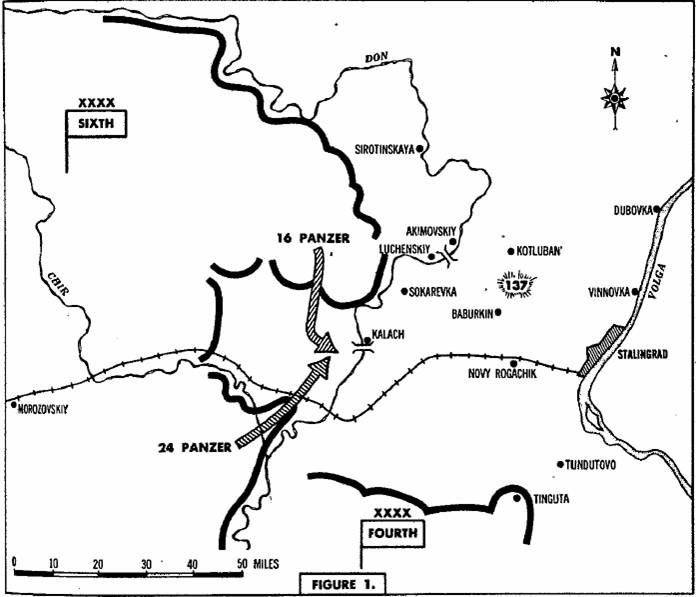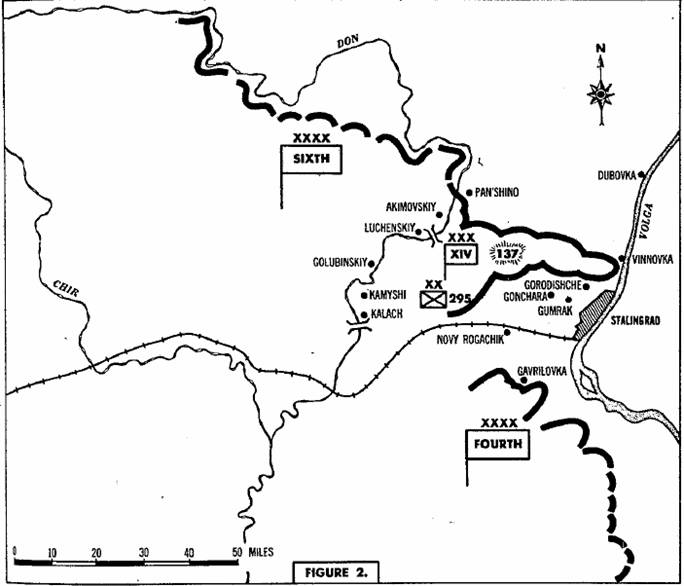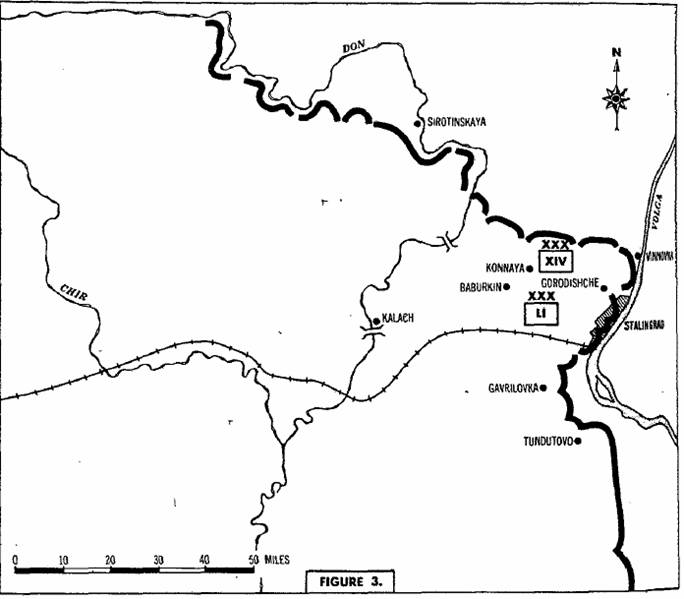ON 30 JUNE 1942 the Sixth Army had left its
jumping off point east of Belgorod, and was
advancing for the attack. After two days of hard
defensive fighting the Russian resistance
appeared to be broken, and the Germah units went
over to the pursuit. It appeared, however, that
the Russian retreat was being conducted on the
basis of previous plans, for during the delaying
action of the withdrawal to the southeast not a
single article of equipment was left behind and
the number of prisoners taken was small. The
extensive Russian minefield considerably slowed
the German advance. But by 20 July 1942 the main
body of the Sixth Army was astride the upper
course of the Chir.
The Sixth Army South of the Don.
The original German plan of operations had
called, for the conquest of the southern Russian
area in chronological phases. First, Army Group
B, with its Sixth Army and First and fourth
Armored Armies, was to seize Stalingrad and the
lower Volga and establish a defense front
between the Don and the Volga. After this, Army
Group A was to seize the Caucasus area to the
south. The German Supreme Command (Hitler)
looked forward to the enemy’s collapse as a
result.
It was fairly
certain that the strategic objectives of this
plan would be reached before winter, even though
the resultan anticipated had to remain very
doubtful, if not dismissed as purely Utopian.
However, in view of
the successful advance of the Sixth Army, the
High Command decided that the Soviet defense was
so shattered already that only fractional forces
were now necessary to bring about the collapse
of the Don-Volga front. Under the impulse of
this wishful thinking, the original operations
plan was discarded and a new directive issued
which allotted to Army Group B with its Sixth
Army and Fourth Armored Army, the Don bend -
Volga bend operations objective while, at the
same time, Army Group A was assigned the mission
of the conquest of the Caucasus area. The idea
of any point of main effort was dissipated by
this dispersal of forces.
The Battle of Kalach.
On the basis of the
manner in which operations had proceeded up to
that point
and with the forces available, it seemed logical,
in July 1942, that the Sixth Army would reach
the crown of the great Don bend at Kalach in a
few days. But many rapid moving, hard-hitting
units, and large quantity of transport materiel
were transferred to Army Group A with the change
in plans. At the moment (22- 24 JuIy) when
everything depended on rapid action and
concentrated effort, an armored division and two
motorized divisions were left without transport
and incapable of movement.
About the same time,
the Russian Command obviously had decided to
defend Stalingrad, not at the gates of the city
but on the west bank of the Don, and on 25 July
assembled forces in the hilly country northwest
of Kalach. A battle took place which put the
Sixth Army formations (which were in a critical
situation with respect to supply) in a most
difficult situation.The enemy not only brought
forward his armored and infantry divisions at
Kalach, but also those farther north in the
vicinity of Akimovskiy across the Don. As a
result of this, the Sixth Army was obliged to
fight a battle on two fronts.
It was forced from
successful pursuit to defense.
The massed Russian attacks, supported by
hundreds of tanks, eventually were repulsed.

After 10 days of the
hardest defense fighting, supplies began
arriving again on
the German side. The divisions again began to
receive motor fuel and ammunition from the
supply bases hundreds of miles to the rear. The
German Army gained the initiative. It saw the
opportunity not only of beating the enemy
installed in a broad, risky semicircle about
Kalach, but of annihilating him by a double
pincers action along the Don.
The attack began early in the morning of 7
August; about 20 hours later, the points of the
16th Armored Division (from the north) and of
the 24th Armored Division (from the south ) met
on the heights west of Kalach.
The Russian Sixty-fourth Army and the First
Armored Army, cut off by this operation;
capitulated three days later.
The enemy - in addition to many casualties -
lost 1,000 tanks and 750 guns. Fifty two
thousand Russians were taken prisoner. However,
the combat strength of the Sixth Army divisions
also had been seriously impaired. Their losses
were felt more since replacements were not
available.
On 29 July General
von Paulus had declared that: “The army is too
weak for the attack on Stalingrad”. And a day
later, the Chief of the Army General Staff,
Major General Schmidt said: “The farther east we
get the weaker we become.” His urgent request
for two or three infantry divisions was turned
down. The combat strength of the Sixth Army was
reduced still further on 10 August by the
withdrawal of an armored and an infantry
division.
The enemy had been beaten in a battle of
annihilation. He had, however, gained time—which
he employed in a most advantageous way—by his
decision to prepare a defense position west of
the Don. In view of his inexhaustible human
reserves this gain of time was of greater weight
than the losses he had suffered at Kalach.
Attack Across the Don.
At dawn on 21 August two divisions crossed the
Don in the face of violent enemy defense action.
By evening they had secured a wide bridgehead.
At noon, 22 August, the 16th Armored Division
and the 3d Motorized Division of the XIV Armored
Corps crossed the Don and made ready, in the
bridgehead, for their attack eastward.
On the same day
General Panlus declared: “ We shall attack
tomorrow from the bridgehead with all our forces,
over Hill 137. If it succeeds, we must count on
the mobile divisions alone remaining for a while
on the hills northwest of Stalingrad. The 76th
and 295th Divisions have little combat strength,
so that the thrust will not be strong—particularly,
we shall have difficulty in the matter of cover
on the south I repeat it once more, that we are
two infantry divisions short".
This estimate of the
commander in chief of the army was to find its
full confirmation in the way the fighting
progressed during tbe following weeks. The 16th
Armored Division had 81 tanks at its disposal,
and the 3d Motorized Division had 42. A few days
later the 60th Motorized Division arrived with
40 additional tanks. Altogether, therefore, the
Sixth Army had only 163 tanks for its attack on
Stalingrad.
The Drive to the Volga.
On 23 August the XIV
Armored Corps drove forward over Hill 137 and to
the east, securing itself with weak fractional
forces in the Kotluban area against enemy action
from the north. By 1700 the scout tanks of the
16th Armored Division were already south of
Vinnovka on the steep bank of the Volga.
The terrain gain was deceptive, for a very large
number of enemy groups still remained behind in
the area passed through. The LI Army Corps,
setting out from its bridgehead position,
reached a line north of Baburkin with its 295th
Division. (Figure 2.)
Since interruption
of the weakly held terrain bridge between the
Don and the Volga could be expected during the
ensuing night, air supply of the XIV Armored
Corps was ordered.

On 24 August the
Russians counterattacked with numerous tanks
from the direction of Dubovka and Panshino. The
Akimovskiy bridge across the Don was partially
destroyed by Russian bomber attacks with the
result that this military route was closed to
traffic for two days.
The expected interruption of the highway east of
Hill 137 was brought about on 25 August. The
connections of the XIV .Armofed Corps with the
west were now broken. A combat team from the
60th Motorized Division, which was crossing
theDon, was given the mission of opening the way
to the east again. The 71st Division forced its
way across the Don north of Kalach and took
Kamyshevski. At the same time the 295th Division
was progressing to the south.
The following figures show how matters stood
with regard to the combat strength of a number
of divisions:
The376th Division, 28 percent; 398th Division,32
percent; 384th Division, 30 percent; and the
305th and the 71st Divisions, 36 percent. They
were reduced, therefore, to companies of from 40
to 50 men.
In contrast with this the companies of the
Russian infantry division showed strength of
from 150 to 180 men.
The Outcome.
The XIV Armored Corps was placed in such a
threatening situation by a powerful, methodical
Russian attack—from both the north and south—that
the corps command proposed its Volga group move
to a position back of Hill 137 during the night
of 26-27 August. Since the highway was now cut
on Hill 137 itself, the Army High Command turned
down this proposal very emphatically and
demanded resistance a outrance until the LI Army,
Corps, attacking from the west, should bring
relief. This corps finally arrived on 29 August.
The drive against Stalingrad itself had to be
halted. It was resumed again hy an army group
order on 30 August, since the Fourth Armored
Army on that day had ruptured the Russian lines
at Gavrilovka.
Best Regards.
For this reason the Sixth Army, in spite of the
extremely critical defense situation, directed
the XIV Armored Corps and the LI Army Corps to
attack in a generally southern direction with
the final objective of annihilating the enemy
forces west of Stalingrad.
While a strong
Russian attack from the north—against the
positions of the XIV
Armored Corps—was
repulsed on 2 September, the fractional forces
of the 60th Motorized Division and 295th
Division gained ground in the direction of
Gonshara-Gumrak.
Early on 3
September, contact was established southeast of
Gonshara with the 24th Armored Division of the
Fourth Armored Army. Even thoug a considerable
tactical success had been achieved, on the same
day the northern front of the XIV Armored Corps
again was badly overrun by the Russians. It was
only possible to repel the Russian attacks at
the cost of serious losses, and the use of the
artillery of the 60th Motorised Division which
was fighting with its front to the south.

An enemy attack of from nine to ten infantry
divisions and five to seven armored Brigades
against the north occurred on 5 September.
By the use of all
available reserves and the expenditure of
unusual quantities of ammunition—and at the cost,
again, of very considerable losses—they were
repelled.
The loss of 114 tanks on the Russian side did
not, in view of the increasingly critical
situation of the XIV Armored Corps,give rise to
any illusions. The combat strength of the German
armored infantry and rifle regiments visibly was
disappearing; ammunition reserves were dwindling
as a result of insufficient transport capacity.
The mobile units of the armored corps were being
worn down. Two days later the LI Army Corps
succeeded in effecting a four-mile-deep
penetration on both sides of Gorodishcbe, which
on 9 September was widened in a northerIy
direction against a bitterly fighting enemy.
Toward the City.
On 13 September the
LI Army Corps set out to the southeast toward
the heart of the city of Stalingrad, whose
outlying areas were taken. On the following day,
two divisions with about a one-mile front,
forced their way through the city and all the
way to the Volga. The main railway station fell
into their hands. For the continuation of the
attack on Stalingrad, on 15 September, three
divisions of the Fourth Armored Army were placed
under the orders of the Sixth Army.
The attack of the two corps gradually cut its
way into the city in costly house to house
fighting. (Figure 3.) In three days the LI Army
Corps lost 61 officers and 1,492 men.
As the resuIt of our own attacks and the repulse
of the Russian counterattacks, the infantry
forces between the Don and the Volga had become
so weakened that theGerman Army High Commend
again requested additional units. Divisional
combat strengths of from 500 to 800 men,
including the officers and noncommissioned
officers, were the rule. Finally it was agreed
that three infantry divisions wouId be with rawn
from the southern front for
the use of the Sixth Army.
In addition to the need for more forces there
was a growing shortage of ammunition for
10-centimeter and 7.5-centimeter cannon, and
8-centimeter mortars. The heavy mortar regiment
was without a round of ammunition.
The reverse of this was true in the case of the
enemy, who had continuing reinforcement and
supply.
On 23 September the
Soviet tanks drove through the main line of
defense in the east wing of the VIII Army Corps
south of Kotluban, and cut the supply route
north of Bal Rososhka, where they were destroyed
on 25 September.
The impossibility of making up for the heavy
losses of the frontline units, reduced to
one-third or one-fifth of their original
etrength, the insufficient supply, and the
continually increasing enemy resistance were
matters which required halting the attack on the
Stalingrad blood mill, and indicated the
necessity for pulling back the front at least to
the west bank of the Don. The objection that
such a withdrawal movement was prohibitory
because of Army Group A, which was fighting in
the Caucasus, was without foundation, for its attack, too,
was halted due to lack of forces.
Every attempt at
resuming the attack thus far had failed in the
face of the stubborn resistance of the
numerically and equipment-wise superior enemy.
The hopelessness of the prospect of being able
to achieve the objectives assigned to Army Group
A should have led to a withdrawal to the lower
course of the Don or to the east side of the
Crimean peninsula.
But the requests and
proposals of Army Group B and of the Sixth Army
fell on deaf ears. Serious opposition to
Hitler’s measures, as leader, had, up to this
point, led only to the deposition of the
objectors.
And so, for the Sixth Army the trail was blazed
to catastrophe.